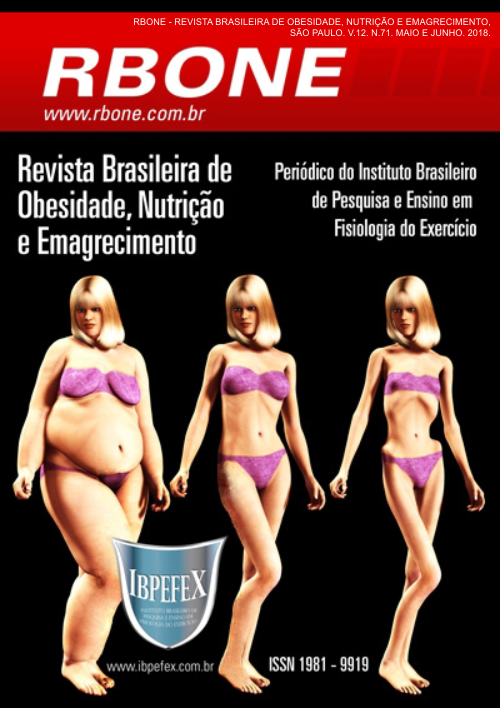Radiographic evaluation of coxofemoral joint in patients submitted to bariatric surgery
Abstract
Introduction: Obesity is a condition characterized by excess of body weight, caused by adipose tissue mass greater than 20% in the individual. Obesity is commonly associated with numerous comorbidities, among them osteoarthrosis, especially in loading joints. The relationship between obesity and osteoarticular lesions of load joints, such as the knee is well defined, but its relation to coxarthrosis is controversial. Objective: The objective of the present study was to investigate possible changes in the coxofemoral joint space in obese patients in comparison with these same patients, after weight reduction caused by bariatric surgery. Materials and methods: This is a prospective study comparing the degree of coxofemoral joint clamping of 16 obese patients, in the pre and postoperative period of bariatric surgery. These patients underwent baseline radiographic examination in orthostasis prior to the procedure and after 6 months. Discussion: The relationship between coxarthrosis and overweight is controversial in the literature. The overload of the articular space with decrease of this, can explain the degeneration of this joint. Results: The radiographic evaluation showed no statistically significant difference in the articular space after bariatric surgery. Conclusion: In view of the results found in this research, it was verified that the joint space coxofemoral, does not suffer direct influence of the overweight or decrease of body mass caused by bariatric surgery.
References
-Conrozier, T.; Lequesne, M.G.; Tron, A.M. Mathiew, P.; Berdah, L.; Vignon, E. The effects of position on the radiographic joint space in osteoarthritis of the hip. Osteoarthritis Cartilage. Vol. 5. Núm. 1. p. 17-22. 1997.
-Gill, R.S.; e colaboradores. The benefits of bariatric surgery in obese patients with hip and knee osteoarthritis: a systematic review. Obesity reviews: an official journal of the International Association for the Study of Obesity. Vol. 12. Núm. 12. p. 1083-9. 2011.
-Hoening, M. Obesity in adults. 2014. Clinical Key, 2014.
-Jiang, L.; e colaboradores. The relationship between body mass index and hip osteoarthritis: A systematic review and meta-analysis. Joint Bone Spine. Vol. 78. p.150-155. 2011.
-Lievense, A.M.; Bierma-Zeinstra, S.M.A.; Verhagen, M.E. Influence of obesity on the development of osteoarthritis of the hip: a systematic review. British Society of Rheumatology. Vol. 41. p. 1155-1162. 2002.
-Lohmander, L.S.; e colaboradores. Incidence of severe knee and hip osteoarthritis in relation todifferent measures of body mass: a population-based prospective cohort study. Annals of the Rheumatic Diseases. Vol. 68. Núm. 4. p. 490-496. 2009.
-Mork, P.J.; e colaboradores. Effect of body mass index and physical exercise on risk of knee and hip osteoarthritis: longitudinal data from the Norwegian HUNT study. Journal of Epidemiology & Community Health. Vol. 66. Num. 8. p. 678-683. 2012.
-Recnik, G.; e colaboradores. The role of obesity, biomechanical constitution of the pelvis and contact joint stress in progression of hip osteoarthritis. Osteoarthritis and Cartilage. Vol. 17. p. 879-882. 2009.
-Sabharwal, S.; Root, M, Z. Impacto da obesidade na ortopedia. The journal of the bone and joint surgery. Vol. 94. p. 1045-1052. 2012.
-Springer, B. D.; e colaboradores. Obesity and the role of bariatric surgery in the surgical management of osteoarthritis of the hip and knee: a review of the literature. Surgery For ObesityAnd Related Diseases. Vol. 13. Núm. 1. p. 111-118. 2017.
-Vanni, G.F.; Stucky, J.M.; Schwarstmann, C.R. Avaliação radiológica do espaço articular na artrose de quadril: estudo comparativo em decúbito e ortostatismo. Revista Brasileira de Ortopedia. Vol. 43. Núm. 10.p. 460-464. 2008.
-Wang, Y.; e colaboradores. Body weight at early and middle adulthood, weight gain and persistent over weight from early adulthood are predictors of the risk of total knee and hip replacement for osteoarthritis. Rheumatology. Vol. 52. p. 1033-1041. 2013.
Authors who publish in this journal agree to the following terms:
- Authors retain the copyright and grant the journal the right of first publication, with work simultaneously licensed under the Creative Commons Attribution License BY-NC which allows the sharing of the work with acknowledgment of the authorship of the work and initial publication in this journal.
- Authors are authorized to enter into additional contracts separately for non-exclusive distribution of the version of the work published in this journal (eg, publishing in institutional repository or book chapter), with acknowledgment of authorship and initial publication in this journal.
- Authors are allowed and encouraged to post and distribute their work online (eg, in institutional repositories or on their personal page) at any point before or during the editorial process, as this can bring about productive change as well as increase impact and impact. citation of published work (See The Effect of Free Access).






